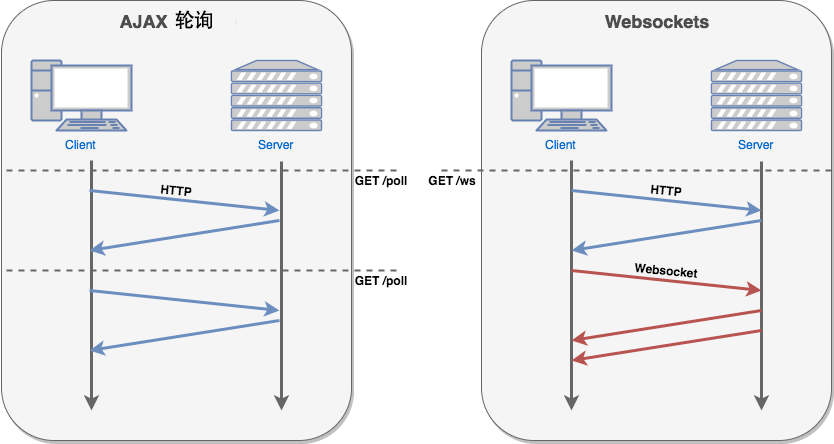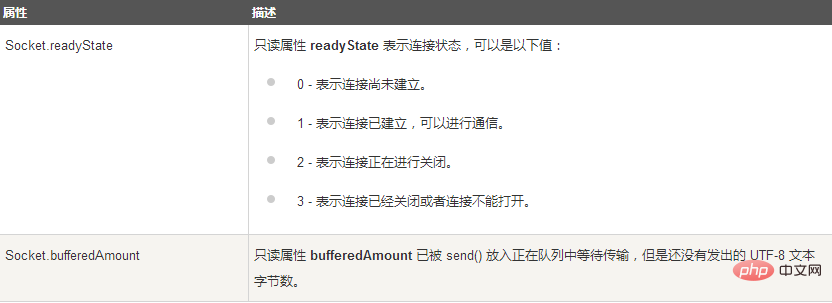What does WebSocket mean in HTML5
1. What does WebSocket mean in HTML5?
WebSocket is a protocol for full-duplex communication on a single TCP connection that HTML5 began to provide. WebSocket makes the data exchange between the client and the server become It is simpler and allows the server to actively push data to the client. In the WebSocket API, the browser and the server only need to complete a handshake, and a persistent connection can be created directly between the two for bidirectional data transmission.

In the WebSocket API, the browser and the server only need to perform a handshake action, and then a fast channel is formed between the browser and the server. Data can be transmitted directly between the two.
Now, in order to implement push technology, many websites use Ajax polling. Polling is when the browser issues an HTTP request to the server at a specific time interval (such as every 1 second), and then the server returns the latest data to the client's browser. This traditional model brings obvious shortcomings, that is, the browser needs to continuously send requests to the server. However, HTTP requests may contain long headers, and the real valid data may be only a small part. Obviously, this will be wasteful. A lot of bandwidth and other resources.
The WebSocket protocol defined by HTML5 can better save server resources and bandwidth, and enable more real-time communication.
The browser sends a request to the server to establish a WebSocket connection through JavaScript. After the connection is established, the client and the server can directly exchange data through the TCP connection.
After you obtain the Web Socket connection, you can send data to the server through the send() method, and receive data returned by the server through the onmessage event.
The following API is used to create WebSocket objects.
var Socket = new WebSocket(url, [protocol] );
WebSocket properties

2. What kind of protocol is Websocket and what are its specific advantages
First of all, Websocket is a persistence protocol, compared to non-persistent protocols such as HTTP.
Let’s give a simple example and use the PHP life cycle that is currently widely used to explain.
1) The life cycle of HTTP is defined by Request, that is, one Request and one Response. In HTTP 1.0, this HTTP request ends.
Improvements were made in HTTP 1.1 so that there is a keep-alive, that is to say, in one HTTP connection, multiple Requests can be sent and multiple Responses can be received.
But please remember Request = Response, this is always the case in HTTP, which means that a request can only have one response. Moreover, this response is also passive and cannot be initiated actively.
The above is the detailed content of What does WebSocket mean in HTML5. For more information, please follow other related articles on the PHP Chinese website!

Hot AI Tools

Undresser.AI Undress
AI-powered app for creating realistic nude photos

AI Clothes Remover
Online AI tool for removing clothes from photos.

Undress AI Tool
Undress images for free

Clothoff.io
AI clothes remover

Video Face Swap
Swap faces in any video effortlessly with our completely free AI face swap tool!

Hot Article

Hot Tools

Notepad++7.3.1
Easy-to-use and free code editor

SublimeText3 Chinese version
Chinese version, very easy to use

Zend Studio 13.0.1
Powerful PHP integrated development environment

Dreamweaver CS6
Visual web development tools

SublimeText3 Mac version
God-level code editing software (SublimeText3)

Hot Topics
 Table Border in HTML
Sep 04, 2024 pm 04:49 PM
Table Border in HTML
Sep 04, 2024 pm 04:49 PM
Guide to Table Border in HTML. Here we discuss multiple ways for defining table-border with examples of the Table Border in HTML.
 Nested Table in HTML
Sep 04, 2024 pm 04:49 PM
Nested Table in HTML
Sep 04, 2024 pm 04:49 PM
This is a guide to Nested Table in HTML. Here we discuss how to create a table within the table along with the respective examples.
 HTML margin-left
Sep 04, 2024 pm 04:48 PM
HTML margin-left
Sep 04, 2024 pm 04:48 PM
Guide to HTML margin-left. Here we discuss a brief overview on HTML margin-left and its Examples along with its Code Implementation.
 HTML Table Layout
Sep 04, 2024 pm 04:54 PM
HTML Table Layout
Sep 04, 2024 pm 04:54 PM
Guide to HTML Table Layout. Here we discuss the Values of HTML Table Layout along with the examples and outputs n detail.
 HTML Input Placeholder
Sep 04, 2024 pm 04:54 PM
HTML Input Placeholder
Sep 04, 2024 pm 04:54 PM
Guide to HTML Input Placeholder. Here we discuss the Examples of HTML Input Placeholder along with the codes and outputs.
 HTML Ordered List
Sep 04, 2024 pm 04:43 PM
HTML Ordered List
Sep 04, 2024 pm 04:43 PM
Guide to the HTML Ordered List. Here we also discuss introduction of HTML Ordered list and types along with their example respectively
 HTML onclick Button
Sep 04, 2024 pm 04:49 PM
HTML onclick Button
Sep 04, 2024 pm 04:49 PM
Guide to HTML onclick Button. Here we discuss their introduction, working, examples and onclick Event in various events respectively.
 Moving Text in HTML
Sep 04, 2024 pm 04:45 PM
Moving Text in HTML
Sep 04, 2024 pm 04:45 PM
Guide to Moving Text in HTML. Here we discuss an introduction, how marquee tag work with syntax and examples to implement.






